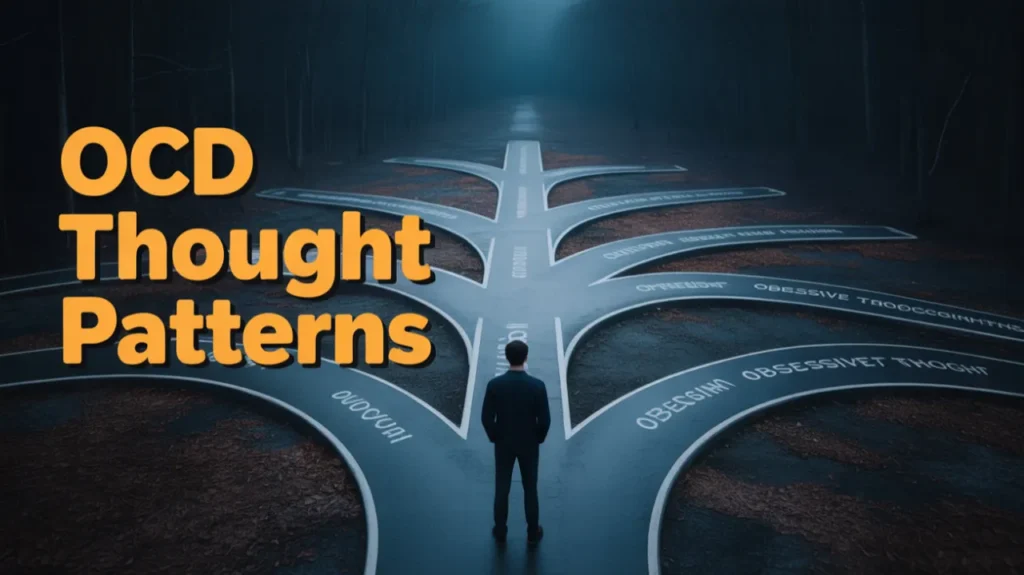OCD vs Anxiety
Obsessive-Compulsive Disorder (OCD) and anxiety are distinct mental health conditions that can look similar but differ in origin, symptoms, and treatment. Both involve fear, distress, and intrusive thought patterns, but their triggers and behavioral expressions vary. Understanding the contrast between OCD and anxiety helps patients seek the right therapy, improve their health, and regain control over daily life.
What Is Anxiety?
Anxiety is the brain’s response to perceived threat or danger. It often causes physical symptoms like shortness of breath, racing thoughts, increased heart rate, and muscle tension. People with an anxiety disorder may experience persistent worry that interferes with their quality of life.

Types of Anxiety Disorders
The Diagnostic and Statistical Manual of Mental Disorders (DSM-5), published by the American Psychiatric Association, defines several anxiety subtypes:
- Generalized Anxiety Disorder (GAD): Chronic worry about daily issues like health, finances, or relationships.
- Panic Disorder: Recurring panic attacks with symptoms such as heart palpitations, breathing difficulty, and a sense of doom.
- Social Anxiety Disorder: Intense fear of social situations, driven by concern over judgment or rejection.
- Specific Phobia: Extreme fear of particular objects or situations, such as heights or contamination.
- Separation Anxiety Disorder: Excessive fear of being away from attachment figures, more common in children but also seen in adults.
These conditions can result in insomnia, irritability, headache, weight loss, and reduced functioning at work or school. Chronic anxiety can also contribute to physical diseases such as type 2 diabetes and ulcerative colitis.
What Is OCD?
OCD is a psychiatric disorder marked by obsessions and compulsions. Obsessions are intrusive thoughts that cause distress, while compulsions are repetitive behaviors aimed at reducing that distress. For example, a patient might experience thoughts about contamination and engage in frequent hand washing as a compulsive behavior.
Core Symptoms of OCD
- Obsessions: Persistent, unwanted thoughts, images, or urges (e.g., fear of harm, perfectionism, contamination, doubt).
- Compulsions: Actions like checking, counting, or repeating that serve to neutralize obsessive thoughts.
- Rumination: Ongoing mental reviewing, often related to uncertainty or fear of making the wrong choice.
These behaviors go beyond general stress and can severely impair emotional, social, and occupational functioning. In some cases, comorbid conditions like hoarding disorder or body dysmorphic disorder also emerge.

Brain Chemistry and Neurotransmitters
Both OCD and anxiety involve dysregulation in brain chemistry. Serotonin, a neurotransmitter responsible for mood and emotion, plays a major role in both conditions. Low levels of serotonin have been linked to OCD and various anxiety disorders.
How Medication Helps
Selective serotonin reuptake inhibitors (SSRIs) such as sertraline, fluoxetine, and fluvoxamine are commonly used. These medications increase serotonin availability in the brain and reduce symptoms over time. Tricyclic antidepressants and anxiolytic drugs may also be prescribed in some cases. In treatment-resistant cases, antipsychotic augmentation is sometimes recommended.
The Food and Drug Administration has approved several medications for both OCD and anxiety treatment. When SSRIs are ineffective alone, some patients respond to a combination of therapy and tricyclic antidepressants. Medication decisions should be guided by a health professional or psychiatrist with experience in treating both conditions.
OCD vs Anxiety: Key Differences
| Feature | OCD | Anxiety |
|---|---|---|
| Core Symptom | Obsessions + compulsions | Excessive worry or fear |
| Focus | Irrational thoughts and rituals | Real-life concerns |
| Behavior | Repetitive actions (e.g., hand washing) | Avoidance or over-preparation |
| Diagnosis | Often involves perfectionism, contamination, symmetry | Includes social anxiety, panic disorder, GAD |
| Response | Relief only after compulsion | May ease with distraction or relaxation |
OCD and anxiety may co-occur, known as comorbidity, which can make diagnosis more difficult. Both can also share overlapping symptoms with bipolar disorder, personality disorder, and major depressive disorder.
Diagnosing OCD and Anxiety
A mental health professional or physician evaluates symptoms using clinical interviews and diagnostic criteria. The evaluation often includes history-taking, physical examination, and psychiatric assessment. Co-existing issues such as major depressive disorder, bipolar disorder, or personality disorder must also be considered.
Role of Genetics and Risk Factors
Family history, trauma, brain injury, and environmental stress can increase the risk for both disorders. Genetics may predispose some individuals to OCD, anxiety disorders, or both. Research continues to study how DNA, neurotransmitter imbalances, and environmental factors contribute to emotional regulation and psychiatric disease.
OCD and Anxiety Triggers
Triggers differ by condition. In OCD, triggers are linked to specific obsessions, such as contamination or fear of harm. In anxiety, triggers are typically broader, like work stress, social interactions, or financial problems.
Common Triggers Include:
- OCD: Dirt, germs, disorder, violence, religious guilt
- Anxiety: Conflict, deadlines, public speaking, uncertainty
Stress management through therapy, coping strategies, and lifestyle changes can reduce symptom severity. Both disorders are tied to high emotional reactivity, often rooted in feelings of fear, doubt, and loss of control.
Therapy Options for OCD and Anxiety
Evidence-based therapy is the frontline treatment for both OCD and anxiety disorders. At Revival Mental Health, we integrate multiple therapy approaches into personalized care plans.
Cognitive Behavioral Therapy (CBT)
CBT helps reframe negative thought patterns. Patients learn to identify and challenge irrational beliefs, reducing fear and distress. This method is widely used across anxiety disorders and OCD-related compulsive behavior.
Exposure and Response Prevention (ERP)
ERP is a specialized form of CBT used for OCD. It exposes patients to anxiety-inducing situations without allowing the compulsive behavior. Over time, this reduces sensitivity to triggers. ERP can be especially effective in treating patients with hygiene obsessions or fear of contamination.
Relaxation Techniques and Coping Skills
For anxiety, breathing exercises, meditation, and mindfulness can help regulate emotional arousal. These are often used alongside therapy. Nutrition, sleep, and exercise also play an important role in maintaining mental health and stabilizing mood.
Medication Management
Medication is frequently combined with therapy. Health professionals may adjust the dose based on patient response and side effects. Benzodiazepine drugs may be used short-term for panic but carry risk of dependency. Anxiolytics and antidepressants like SSRIs are more common for long-term use.
FDA-Approved Medications
The Food and Drug Administration approves several SSRIs and SNRIs (serotonin-norepinephrine reuptake inhibitors) for both OCD and anxiety. Fluvoxamine is often used in OCD cases, while sertraline and fluoxetine are used across anxiety spectrum disorders. Tricyclic antidepressants and newer antipsychotic drugs are also explored in complex cases.
Physical Symptoms and Misdiagnosis
Both disorders share physical symptoms that can lead to misdiagnosis. These include:
- Headache
- Muscle tension
- Shortness of breath
- Palpitations
- Sleep issues
- Racing thoughts
Chronic anxiety may also increase inflammation, disrupt the immune system, and aggravate physical conditions like diabetes or ulcerative colitis. Poor nutrition and unmanaged stress can make symptoms worse and reduce the body’s natural resilience.
Quality of Life and Daily Impact
Untreated OCD and anxiety can lead to poor hygiene, social withdrawal, occupational burnout, and even substance use. Emotional strain affects lifestyle, eating habits, sleep, and overall health. Health care access, insurance barriers, and stigma can prevent patients from receiving timely care.
Risk Factors for Poor Outcomes
- Avoidance of therapy
- Misuse of drugs or alcohol
- Exposure to domestic violence
- Lack of insurance or access to qualified psychiatry professionals
Education, early evaluation, and access to treatment improve mental health outcomes and reduce the burden of disease. Revival Mental Health supports patients through a wide network of care, from diagnosis to therapy and ongoing psychiatric management.
When to Seek Help
If obsessive thoughts or anxiety symptoms disrupt daily functioning, seek help from a licensed therapist or psychiatrist. Early intervention improves outcomes. Revival Mental Health offers expert evaluation, personalized treatment, and ongoing support for OCD, anxiety, and related disorders.

FAQs
1. Are OCD and anxiety treated by the same type of therapist?
Yes. A mental health professional trained in CBT or ERP can treat both OCD and anxiety, though treatment strategies differ slightly.
2. Can OCD and anxiety cause physical illness?
Yes. Chronic stress from either condition may worsen physical health, impacting digestion, immunity, and sleep patterns.
3. Do OCD patients always know their thoughts are irrational?
Often yes. OCD patients are typically aware that their obsessions are not logical but still feel compelled to act on them.
4. Can OCD or anxiety lead to psychosis?
While rare, severe untreated cases may increase the risk of psychosis, especially in the presence of comorbid conditions or medication misuse.





